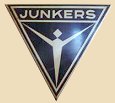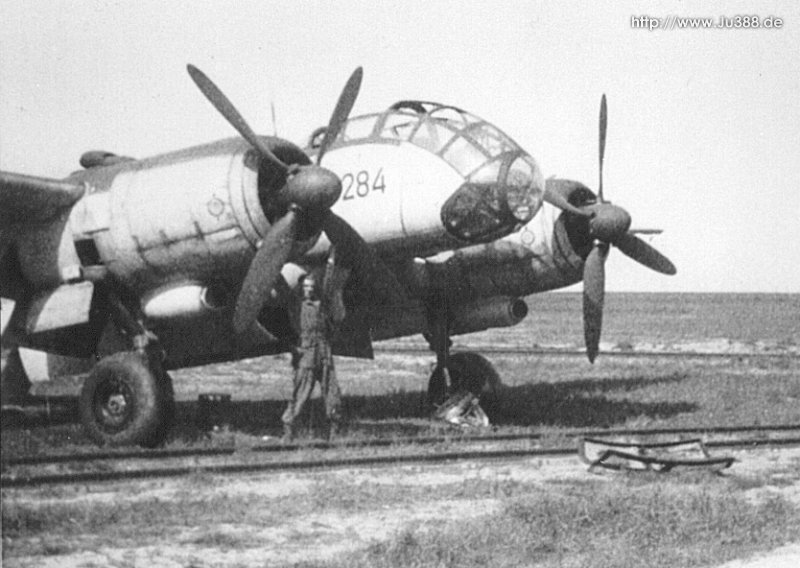



Junkers aircraft, the once world famous company from Dessau,
designed and produced aircraft from mid-WW I until the Nazi rule ended in 1945. Many of
the Junkers planes were milestones in the development of flight. The world's first
all-metal aircraft was built in Dessau as well as the world's first all-metal passenger
aircraft.
On the occasion of the presentation of the newly restored Junkers W 33 "Bremen",
D-1167, c/n 2504 the type W 33 was added to this little gallery. The "Bremen"
was the first plane to cross the Atlantic in the much more tricky East-West-direction. In
spite of a discouraging first attempt which failed on August 14, 1927, the
"Bremen" took off again at the Berlin-Tempelhof airfield on March 26, 1928. In
Baldonell/Ireland, Freiherr von Hünefeld and Hermann Köhl picked up the Irish Major
Fitzmaurice. Because of bad weather, the plane could not start again until April 12, 1928.
After more than 36 hours of flying, the plane touched down near the Greenly Island
Lighthouse, which is in Labrador. The crew was enthusiastically celebrated in New York and
several German cities.
Why was the aircraft named "Bremen"? As you all know, Bremen is a city in
northern Germany, and it is anything but close to the Junkers company headquarters in
Dessau. In those days, Freiherr von Hünefeld was PR manager of the Norddeutscher Lloyd, a
famous German shipping company. They had just baptised their latest ships for the
transatlantic route "Bremen" and "Europa". Provided that there were
two planes named "Europa" and "Bremen", the Norddeutscher Lloyd was
willing to finance the enterprise. And when the first attempt was made in Dessau in 1927,
there was a second plane, the D-1197 "Europa", c/n 2505...
Junkers W 33 |
The newly restored Junkers W 33 "Bremen", D-1167, c/n 2504, during presentation in Bremen |
|
| Year: | 17.6.1926 | |
| Length: | 10,90 m | |
| Wingspan: | 17,70 m | |
| Height: | 3,50 m | |
| Engine: | Junkers L 5 | |
| with: | 360 PS | |
| Number of Engines: | 1 | |
| Top speed: | 160 km/h | |
| Range: | ~ 6000 km | |
| Usage: | Transport | |
| Crew: | 2+1 | |
| Nickname: | Bremen | |
| Armament: | none | |
| Weight (empty): | 1350 kg | |
| Gross Weight: | 3815 kg | |
| Built: | ||
Most people have at least heard of the Junkers Ju 52, a passenger aicraft and military transport.
The Junkers Ju 88 was one of the most-built German aircraft of WW II. It served as destroyer, fighter, night-fighter and bomber.
Ju 88 A |
 This color photograph is actually a Junkers postcard from WW II, and the description on the backside says: "Junkers military aircraft are securing the Mediterranean. Junkers - Ju 88 group at the foot of the Aetna (Sicily)" |
|
| Year: | 1936 | |
| Length: | 14,96 m | |
| Wingspan: | 20,08 m | |
| Height: | 5,10 m | |
| Engine: | Junkers Jumo 211 | |
| with: | 1420 HP | |
| Number of Engines: | 2 | |
| Top speed: | 498 km/h | |
| Range: | 3380 km | |
| Usage: | Bomber, Night-Fighter | |
| Crew: | 3 persons | |
| Nickname: | ||
| Armament: | various | |
| Weight (empty): | 9000 kg | |
| Gross Weight: | 12800 kg | |
| Built: | ca. 15000 | |
The Ju 388 L was derived from the Ju 88 family, but never entered service:
Ju 388 L-1 |

This Junkers Ju 388 L-1, c/n 340 284, was manufactured by ATG. |
|
| Year: | 1943 | |
| Length: | 14.87 m | |
| Wingspan: | 22.00 m | |
| Height: | 4.90 m | |
| Wing Area: | 56 m² | |
| Engine: | BMW 801 TJ-0 | |
| with: | 1615 HP | |
| Number of Engines: | 2 | |
| Top speed: | 616 km/h | |
| Range: | 2,220 km | |
| Ceiling: | 12,800 m | |
| Usage: | Reconnaissance | |
| Crew: | 3 persons | |
| Nickname: | Störtebeker | |
| Armament: | 2 MG 131 | |
| Weight (empty): | 10,000 kg | |
| Gross Weight: | 13,700 kg | |
| Built: | ~ 100 | |
 |
Exclusive - The Ju 388 Page |
Ju 90 V1 |
 In this image, the Ju 90 V-1, D-AALU, seems to have just been pulled out of the hangar. At the left edge, part of a caterpillar tractor is visible. |
|
| Year: | 1937 | |
| Length: | 26,45 m | |
| Wingspan: | 35,27 m | |
| Height: | 6,65 m | |
| Engine: | DB 600 A | |
| with: | 1000 HP | |
| Number of Engines: | 4 | |
| Top speed: | 350 km/h | |
| Range: | 1000 km | |
| Usage: | airliner | |
| Crew: | ||
| Nickname: | ||
| Armament: | none | |
| Weight (empty): | ||
| Gross Weight: | ||
| Built: | 1 | |
Ju 90 (series) |
 The Ju 90 WNr. 0009, BJ+OV ex D-AJHB "Thüringen" is refuelled at Athens-Tatoi airport for an Iraq mission. Note that the spinner on the left starboard engine is missing. |
|
| Year: | 1937 | |
| Length: | 26,45 m | |
| Wingspan: | 35,27 m | |
| Height: | 6,65 m | |
| Engine: | BMW 132 | |
| with: | 830 HP | |
| Number of Engines: | 4 | |
| Top speed: | 350 km/h | |
| Range: | ~ 1500 km | |
| Usage: | airliner | |
| Crew: | ||
| Nickname: | ||
| Armament: | none | |
| Weight (empty): | ||
| Gross Weight: | ||
| Built: | 10 | |
The Junkers Ju 290 was conceived as transport and also used as reconnaissance plane:
Ju 290 A-5 |
 |
|
| Year: | 1942 | |
| Length: | 28,50 m | |
| Wingspan: | 42,00 m | |
| Height: | 6,90 m | |
| Engine: | BMW 801 D | |
| with: | 1800 HP | |
| Number of Engines: | 4 | |
| Top speed: | 455 km/h | |
| Range: | 6760 km | |
| Usage: | Reconnaissance | |
| Crew: | 6 persons | |
| Nickname: | Seeadler (Sea Eagle) | |
| Armament: | 3 MG 151/20, 2 MG 81 | |
| Weight (empty): | 24085 kg | |
| Gross Weight: | 41305 kg | |
| Built: | 46 | |
Further images of the Ju 290...
